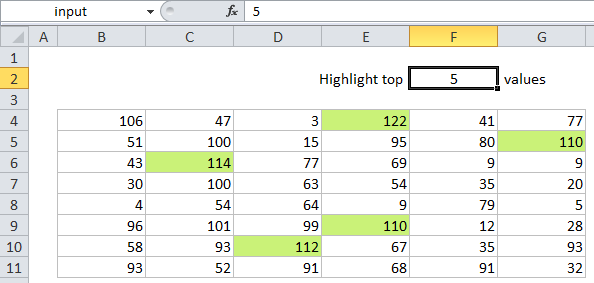Highlight bottom values in Excel
This tutorial shows how to Highlight bottom values in Excel using the example below;
Formula
=A1<=SMALL(data,N)

Explanation
To highlight the smallest (bottom) values in a set of data with conditional formatting, you can use a formula based on the SMALL function.
In the example shown, the formula used for conditional formatting is:
=B4<=SMALL(data,input)
Note: Excel contain a conditional formatting “preset” that highlights bottom values. However, using a formula instead provides more flexibility.
How this formula works
This formula uses two named ranges: data (B4:G11) and input (F2). These are for readability and convenience only. If you don’t want to use named ranges, make sure you use absolute references for both of these ranges in the formula.
This formula is based on the SMALL function, which returns the nth smallest value from a range or array of values. The range appears as the first argument in SMALL, and the value for “n” appears as the second:
SMALL(data,input)
In the example, the input value (F2) is 5, so SMALL will return the 5th smallest value in the data, which is 9. The formula then compares each value in the data range with 9, using the less than or equal to operator:
=B4<=SMALL(data,input) =B4<=9
Any cell with a value less than or equal to 9 triggers the rule, and the conditional formatting is applied.